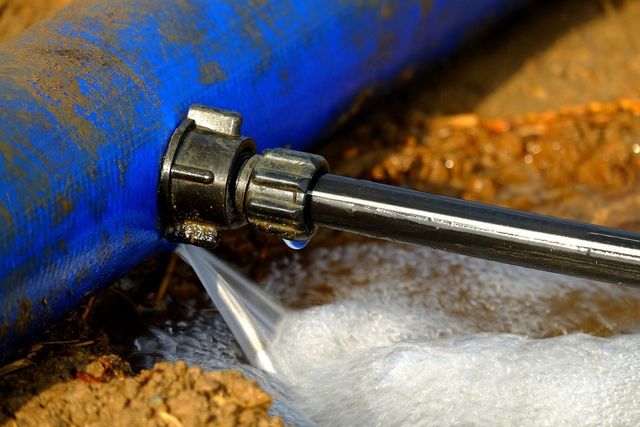Exactly how to Discover and Repair Water Leaks-- A Comprehensive Overview
Exactly how to Discover and Repair Water Leaks-- A Comprehensive Overview
Blog Article
What're your opinions on Leaking water lines?

Early detection of dripping water lines can minimize a potential calamity. Some tiny water leaks may not be visible.
1. Take A Look At the Water Meter
Every residence has a water meter. Checking it is a surefire way that assists you find leakages. For beginners, turn off all the water sources. Make sure no person will flush, utilize the faucet, shower, run the washing device or dishwashing machine. From there, go to the meter and watch if it will certainly transform. Because nobody is using it, there ought to be no motions. That indicates a fast-moving leak if it moves. Also, if you spot no changes, wait a hr or more as well as inspect back once again. This suggests you might have a slow leakage that could even be below ground.
2. Examine Water Consumption
Examine your water expenses and track your water intake. As the one paying it, you must discover if there are any disparities. If you detect sudden changes, in spite of your usage being the same, it suggests that you have leakages in your plumbing system. Remember, your water costs must fall under the exact same range every month. An abrupt spike in your bill shows a fast-moving leak.
Meanwhile, a consistent increase each month, even with the very same practices, reveals you have a slow leak that's additionally slowly intensifying. Call a plumber to extensively examine your building, especially if you really feel a cozy area on your floor with piping below.
3. Do a Food Coloring Examination
When it comes to water intake, 30% comes from commodes. If the shade in some way infiltrates your dish throughout that time without flushing, there's a leakage in between the storage tank as well as dish.
4. Asses Outside Lines
Don't forget to examine your exterior water lines as well. Should water seep out of the link, you have a loosened rubber gasket. One small leak can waste loads of water and also increase your water expense.
5. Inspect and also Examine the Circumstance
Home owners ought to make it a practice to check under the sink counters and also even inside cabinets for any kind of bad odor or mold development. These two warnings suggest a leakage so timely attention is called for. Doing routine inspections, also bi-annually, can save you from a significant trouble.
Examine for stainings and compromising as a lot of pipelines and also devices have a life span. If you believe dripping water lines in your plumbing system, don't wait for it to escalate.
Early detection of leaking water lines can alleviate a possible calamity. Some little water leakages might not be noticeable. Checking it is a surefire way that helps you find leaks. One small leak can squander heaps of water and also increase your water expense.
If you presume dripping water lines in your plumbing system, do not wait for it to intensify.
How to Know If Your Home Has a Hidden Leak
Water Meter Reveals Inexplicable Water Usage
If you’d like to test whether or not there’s a leak somewhere in your home, you can do this using your water meter. Here is how to conduct the test:
Don’t use any water in your home for at least 30 minutes; this also means not turning on faucets or water-using appliances.
Go outside, and check your water meter for activity.
If your water meter shows that there was activity, even though no one was using any water, this proves that there is a leak in your home.Visible Mold or Mildew Growth
Leaks behind walls create moist, dark environments that allow mold and mildew to grow and thrive. Eventually, you might see mold growth forming on the wall closest to a hidden leak.
If mold is growing in an area that receives a high amount of moisture, such as a bathroom, it may simply be an indication that better ventilation is needed. However, if you see mold growth on a wall or the ceiling in an area where you would not expect, you probably have a hidden leak.
Musty, Mildew Odor
Sometimes you might not be able to see the mold or mildew that is growing as a result of a leak. However, the smell can give the problem away just as easily. If you catch a whiff of something musty, there’s a good chance that old water is collecting somewhere in your home that you can’t see.
Stained/Warped Walls, Ceilings, or Floors
When your home soaks up water, a variety of red flags can become visible, including ceiling stains, bubbling drywall, warped walls, and sagging floors. While these issues can be caused by excess humidity, they can also be signs that a pipe or plumbing connection has started leaking behind your walls.
Inexplicably High Water Bill
After a while, you get a general sense for what your water bill should be. If you own a pool or sprinkler system, your bill will tend to be higher during summer. However, if you receive a water bill that seems especially high, and you can’t figure out what caused it, then you may have a hidden leak somewhere that’s increasing your bill.
https://www.plumbingjoint.com/blog/2019/july/how-to-know-if-your-home-has-a-hidden-leak/

Do you like reading about Detecting hidden plumbing leaks? Create a remark directly below. We'd be glad to hear your reactions about this article. We hope that you come back again in the near future. Remember to take a moment to distribute this post if you enjoyed reading it. We appreciate reading our article about Top leak detection hacks.
Report this page